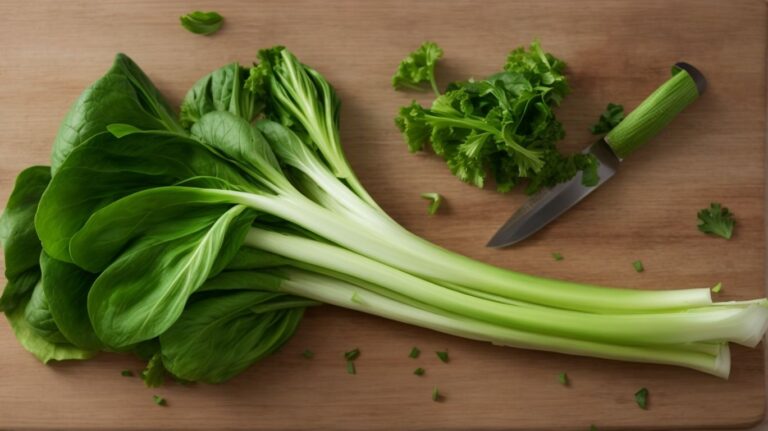How to Cook Egusi Soup With Tomatoes?
Are you looking to spice up your cooking routine with a delicious and traditional African dish? Look no further than Egusi Soup!
Discover what Egusi Soup is, the ingredients needed to make it, and the different variations you can try. Learn the step-by-step process of preparing this flavorful soup and receive some expert tips to elevate the dish.
And don’t worry, we’ll also share some serving suggestions to help you enjoy your Egusi Soup to the fullest. Let’s get cooking!
Key Takeaways:
What Is Egusi Soup?
Egusi Soup is a traditional African dish known for its rich and delicious taste, often prepared with assorted meats and traditional spices.
Origins of Egusi Soup can be traced back to various West African countries, where it holds a significant place in culinary traditions. It is typically made with ground melon seeds that add a unique nutty flavor to the dish. The soup can contain a variety of ingredients such as bitter leaf, pumpkin seeds, and palm oil, contributing to its complex and savory taste profile.
In many African cultures, Egusi Soup is a staple dish served during special occasions and gatherings, symbolizing unity and abundance. Its versatility allows for different meats like goat, chicken, or fish to be incorporated, adding layers of flavor and texture.
What Are the Ingredients for Egusi Soup?
The Ingredients for Egusi Soup typically include fresh tomatoes, assorted meats, smoked fish, traditional spices, and the key ingredient – ground egusi seeds.
Each component in Egusi Soup plays a vital role in shaping its rich flavors and textures. Fresh tomatoes bring a vibrant color and tangy sweetness to the dish, while assorted meats like goat, beef, or chicken add depth and protein. The smoked fish infuses a distinctive smoky aroma that enhances the overall taste profile. Traditional spices such as locust beans, crayfish, and pepper create a harmonious blend of savory and spicy notes.
Before cooking, the ground egusi seeds are mixed with water to form a thick paste, which acts as a thickening agent and imparts a unique nutty flavor to the soup. Maintaining the authenticity of the recipe ensures that the balance of flavors and textures is preserved, resulting in a delicious and satisfying dish that truly represents the culinary heritage of Egusi Soup.
What Are the Different Variations of Egusi Soup?
Egusi Soup boasts a variety of regional and personal variations, influenced by cultural practices and individual preferences.
For instance, in Togo, Egusi Soup often includes a unique blend of spices and vegetables like okra or leafy greens, creating a rich and hearty dish with a slightly thicker consistency. On the other hand, the Yoruba people of Nigeria have their version, typically spicier and more aromatic, featuring a medley of peppers and indigenous herbs.
A common thread among these diverse adaptations is the use of ground melon seeds (egusi) as the base, providing a creamy texture and nutty flavor that ties everything together. Each household may have its secret ingredient or method, passed down through generations, like incorporating a dash of palm oil or crayfish for added depth.
How to Prepare Egusi Soup?
Preparing Egusi Soup involves a series of steps that include frying the blended egusi seeds, stewing with meats, and adding a mix of spices for enhanced flavor.
Once you have the blended egusi seeds ready, heat some palm oil in a pot and fry the seeds until they start to thicken. This process helps to develop a nutty flavor and aroma that will infuse the soup. Next, add in your choice of meats, such as beef, goat, or fish, along with some chopped onions, tomatoes, and peppers.
To make the soup rich and creamy, you can incorporate thickeners like ground crayfish or melon seeds. These ingredients not only enhance the texture but also contribute to the overall depth of flavor in the dish.
Seasoning is crucial in achieving the perfect balance of flavors. Common spices to include are dried fish, locust beans, and ground crayfish. Adjust the seasoning to your preference, tasting as you go to ensure the flavors are well-balanced before simmering the soup to perfection.
Step 1: Soak the Egusi Seeds
To kick off the preparation process, start by soaking the egusi seeds to soften them and draw out their reddish hue.
Egusi seeds, with their melon-like properties, need to be immersed in water to enhance their texture and color. During soaking, these seeds undergo a remarkable transformation as they plump up and become more vibrant.
- This step is crucial as it ensures that the seeds become easier to blend into a smooth paste later on in the cooking process.
- By soaking the egusi seeds, you are also infusing them with moisture, which helps in achieving a creamy consistency in the soup.
Step 2: Blend the Egusi Seeds
Next, blend the soaked egusi seeds to achieve a smooth paste-like consistency that will form the base of the soup.
Blending the egusi seeds is a crucial step in creating the signature texture and flavor of egusi soup. The seamless blend ensures that the rich nuttiness of the seeds permeates the entire dish, giving it a velvety finish.
This paste-like consistency also plays a key role in thickening the soup, providing a hearty and satisfying meal. The smooth texture of the blended seeds harmonizes well with the mucilaginous nature of okra, creating a luscious mouthfeel that is both comforting and indulgent.
For a balanced meal, pair this hearty egusi soup with garri, a staple food in many West African countries. The combination of the creamy soup and the slightly crunchy garri offers a delightful contrast in textures.
To complement the richness of the soup, consider serving it with a side of vibrant green vegetables, such as spinach or bitter leaf. The freshness of the greens adds a pop of color and nutrients to the meal.
Alternatively, you can enjoy the egusi soup with a serving of fluffy white rice. The neutral flavor of the rice serves as a perfect canvas for the bold flavors of the soup, creating a well-rounded and satisfying culinary experience.
Step 3: Prepare the Tomatoes
In this step, prepare the tomatoes by frying them in oil along with tomato paste to create a flavorful and spicy base for the Egusi Soup.
When frying the tomatoes, it’s essential to let them cook until they are nicely caramelized, as this process intensifies the sweetness and deepens the overall flavor of the soup base. The combination of the oil and tomato paste helps to form a rich, thick texture that will coat the egusi seeds perfectly, allowing them to absorb all the delicious flavors during cooking. This technique not only adds complexity to the soup but also enhances its color and aroma, making it even more appetizing.
Step 4: Cook the Egusi Soup
Finally, cook the Egusi Soup by combining the blended egusi paste with the stewed meats and allowing the flavors to meld into a rich and savory dish.
To achieve the desired consistency of the Egusi Soup, you can add thickeners like ground crayfish or even a bit of cornstarch mixed with water. This helps to give the soup a thicker and more hearty texture.
Remember, the key to a delicious Egusi Soup lies in simmering it gently after combining all the ingredients. This allows the flavors to fully infuse into the dish, creating a harmonious blend of flavors.
Be patient during this step, as it ensures a truly satisfying culinary experience.
What Are the Tips for Cooking Egusi Soup?

Credits: Poormet.Com – David Baker
Enhance your Egusi Soup preparation with these expert tips to ensure a delicious and satisfying outcome.
One effective way to enhance the flavor of your Egusi Soup is by toasting the melon seeds before blending them. This simple step brings out a nutty aroma that adds depth to the dish. Consider adding a touch of smoked fish or stock for a rich umami flavor.
Another tip is to experiment with different vegetables such as spinach, pumpkin leaves, or okra to introduce new textures and tastes to your soup.
Incorporating a bit of crayfish powder or shrimp can elevate the overall taste profile. Adjusting the seasoning levels by gradually adding seasonings and spices while tasting along the way will help you achieve a perfectly balanced flavor.
Don’t forget that allowing your soup to simmer and develop flavors slowly over low heat can make a significant difference in the final taste.
Tip 1: Use Fresh and Ripe Tomatoes
For the best results, choose fresh and ripe tomatoes to elevate the flavor profile of your Egusi Soup, ensuring a delicious and tangy taste.
Tomatoes play a crucial role in the depth of flavors in this traditional dish. Opting for ripe tomatoes not only adds a natural sweetness but also contributes to the richness of the soup. When selecting your tomatoes, look for ones that are firm to the touch, vibrant in color, and with a slight give. These qualities indicate that the tomatoes are at their peak ripeness, offering a burst of freshness to your Egusi Soup.
Tip 2: Add Palm Oil for Authentic Flavor
Incorporate palm oil into your Egusi Soup for an authentic and robust flavor that complements the dish’s traditional roots.
Palm oil plays a crucial role in Egusi Soup, not only for its rich taste but also for its cultural significance. In traditional African cuisine, palm oil is a staple ingredient known for adding depth and authenticity to dishes. When simmered with the melon seeds and aromatic spices in Egusi Soup, the palm oil infuses the dish with a distinctive nutty flavor and a vibrant red hue that is visually appealing and indicative of its traditional preparation.
Tip 3: Use Stock for Extra Flavor
Boost the flavor of your Egusi Soup by incorporating a savory stock base infused with aromatic spices for a truly delightful culinary experience.
When preparing Egusi Soup, choosing the right stock can make all the difference in the final dish. A rich homemade chicken or beef broth adds depth and umami notes, elevating the flavors of the soup to new heights. The slow simmering of bones and seasonings in the stock infuses it with a robust taste that permeates through every spoonful of the soup. Don’t underestimate the power of aromatic spices like ground crayfish, locust beans, and smoked fish to further enhance the overall taste profile of the dish.
How to Serve Egusi Soup?

Credits: Poormet.Com – David Robinson
Discover the best ways to serve Egusi Soup to fully enjoy its rich and aromatic flavors, paired with complementary accompaniments.
Egusi Soup, a popular Nigerian dish, is a flavorful blend of ground melon seeds, various spices, and vegetables. To elevate this dish, consider serving it with traditional accompaniments like fufu, rice, plantains, or even yam. These pairings enhance the dining experience by providing different textures and flavors that complement the soup’s creamy consistency.
When preparing Egusi Soup, experimenting with spices like locust beans, crayfish, and red palm oil can add depth and complexity to the overall taste. The versatile nature of this soup allows for customization to suit diverse preferences, making it a versatile and satisfying option for any occasion.
Serving Suggestion 1: With Fufu or Pounded Yam
Pair your Egusi Soup with fufu or pounded yam for a classic and satisfying meal that combines rich flavors and textures.
When combining Egusi Soup with fufu or pounded yam, you create a delightful culinary experience that celebrates the bold flavors of Nigerian cuisine. The smooth and velvety texture of the soup harmonizes perfectly with the starchy, dense nature of the fufu or pounded yam, creating a satisfying contrast of consistencies.
It’s crucial to pay attention to the consistency of both elements to achieve the ideal balance. The slightly neutral taste of the fufu or pounded yam acts as a perfect base for the flavorful and aromatic Egusi Soup, allowing the soup’s essence to shine through.
Serving Suggestion 2: With Rice or Plantains
Serve Egusi Soup with a side of rice or plantains for a satisfying and flavorful meal that blends well with the rich and savory soup.
When pairing Egusi Soup with rice, the fluffy texture of the rice complements the thick and nutty soup, creating a delightful contrast in both flavor and consistency.
On the other hand, serving the soup with plantains offers a sweet and slightly caramelized counterpart to the savory depth of the soup, resulting in a mouthwatering fusion of tastes.
To ensure a harmonious dining experience, it’s crucial to balance the flavors and textures. Consider the softness of the rice or the slightly crunchy plantains against the velvety smoothness of the soup. The interplay of these elements creates a well-rounded meal that satisfies both the palate and the soul.
Experimenting with different serving variations can open up a world of culinary possibilities, allowing you to discover your preferred combination of flavors and textures for the perfect Egusi Soup experience.
Serving Suggestion 3: With Eba or Semolina
Opt for serving Egusi Soup with Eba or Semolina to enjoy a hearty and comforting meal that showcases the soup’s rich flavors and comforting textures.
Combining the savory, nutty taste of the Egusi Soup with the smooth and slightly fluffy texture of Eba or the more substantial Semolina creates a delightful contrast on your palate.
The Eba or Semolina provides a perfect base to soak up the flavorful broth of the soup, enhancing each bite with a satisfying blend of flavors.
This pairing is ideal for those looking for a warm and nourishing meal that offers a balance of richness and simplicity, making it a popular choice among individuals seeking a wholesome dining experience.
Frequently Asked Questions
Can I use fresh tomatoes to make Egusi Soup?
Yes, you can use fresh tomatoes to make Egusi Soup. Fresh tomatoes will add a delicious, tangy flavor to the soup that complements the nutty flavor of the Egusi seeds.
How do I prepare the tomatoes for Egusi Soup?
To prepare the tomatoes for Egusi Soup, wash and chop them into small pieces. You can also blend them for a smoother texture. Be sure to remove the seeds before using them in the soup.
What is the best way to incorporate the tomatoes into Egusi Soup?
The best way to incorporate the tomatoes into Egusi Soup is to add them towards the end of the cooking process. This helps to retain their vibrant color and fresh flavor.
Can I substitute canned tomatoes for fresh tomatoes in Egusi Soup?
Yes, you can substitute canned tomatoes for fresh tomatoes in Egusi Soup. However, keep in mind that canned tomatoes may have added salt and preservatives, which can alter the taste of the soup.
What other ingredients can I add to Egusi Soup with tomatoes?
You can add a variety of ingredients to Egusi Soup with tomatoes, such as onions, peppers, meat, fish, and spices. These ingredients will add more flavor and texture to the soup.
How do I prevent the tomatoes from overpowering the flavor of Egusi Soup?
To prevent the tomatoes from overpowering the flavor of Egusi Soup, use them in moderation. You can also balance out the flavors by adding more Egusi seeds or other ingredients such as onions and spices.






